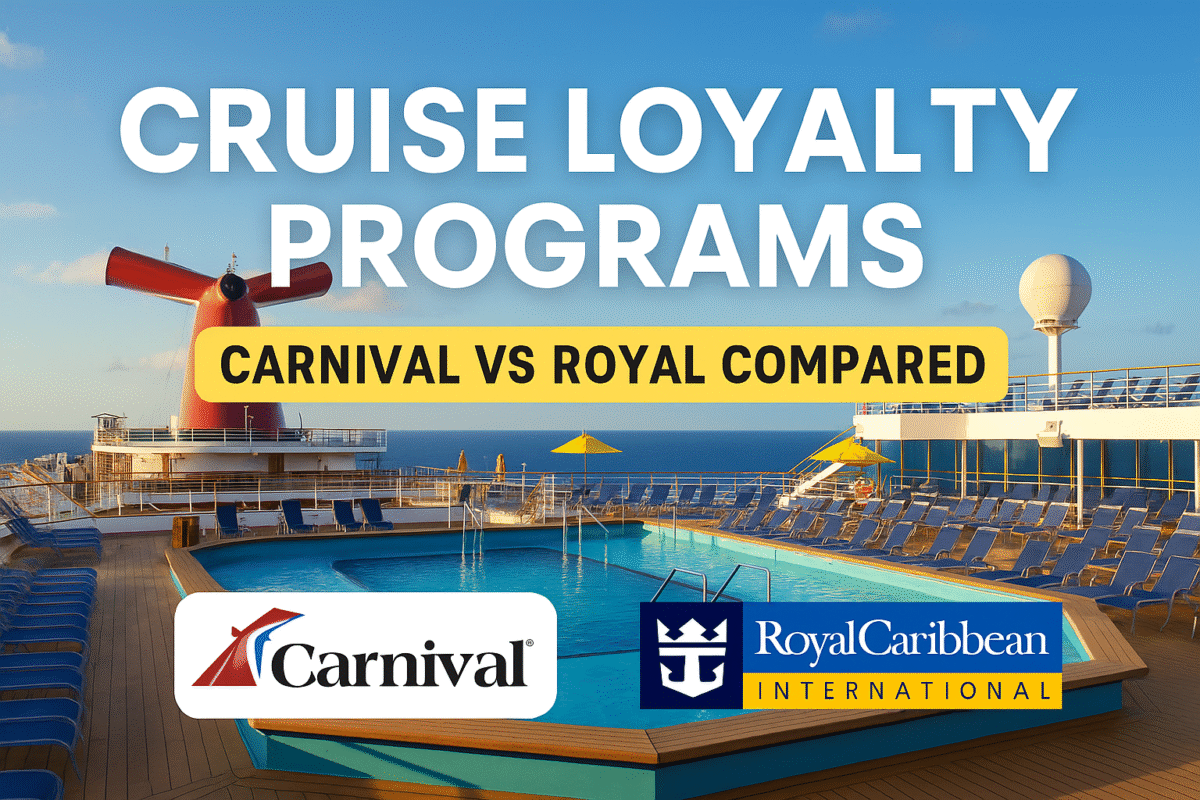f you’ve taken more than one cruise, chances are you’ve at least heard of cruise loyalty programs. Maybe you’ve racked up a few perks without realizing it, or maybe you’ve been intentionally sailing the same line to climb the status tiers. Either way, things are changing—especially with Carnival’s newly announced shift to a spend-based rewards system launching June 2026.
In this post, we’re comparing Royal Caribbean’s Crown & Anchor Society with Carnival’s current and upcoming programs, breaking down exactly what each offers, and whether those shiny perks are still worth chasing. Spoiler: the answer depends on how you cruise.
Royal Caribbean’s Crown & Anchor Society: Status Built on Nights
Royal Caribbean’s loyalty program, Crown & Anchor Society, is a classic example of rewarding time, not spending. Unlike newer loyalty models that focus on how much money you drop onboard, Royal keeps things simple: you earn points based on how many nights you sail.
How You Earn:
- 1 point per night in a standard room
- 2 points per night if you sail solo or book a suite
What makes this model appealing is its clarity—there’s no confusion about what counts. Nights are nights. And the more you cruise, the more you get.
Status Levels & Perks:
There are six tiers in the Crown & Anchor Society, each with gradually increasing rewards:
Gold (3+ points):
Even after one cruise, you hit this level. Perks include:
- Discounts on drinks (beer, wine, soda, coffee)
- Internet and spa discounts
- Exclusive member offers
- Access to private departure lounge
- Casino credits, youth member perks, and more
Platinum (30+ points):
You get everything from Gold, plus:
- Better drink and internet discounts
- Laundry and photo discounts
- Priority access to select events
Emerald (55+ points):
A minor bump—mostly increased casino play credit and better photo discounts.
Diamond (80+ points):
This is where the program really shines:
- 4 complimentary drinks per day, per person (not just per cruise!)
- Free internet day
- Crown Lounge access with happy hour
- Backstage tours, priority dining seating, lapel pin, photo perks
Diamond Plus (175+ points):
All Diamond perks, plus:
- 5 daily drinks
- Additional dining discounts
- 2 days of free internet
- Access to exclusive events like “Cheers with an Officer”
Pinnacle Club (700+ points):
The holy grail of cruise loyalty. This level takes serious dedication—we’re talking years of cruising. Benefits include:
- 6 daily drinks per person
- Unlimited surf & stream Wi-Fi for one device
- Coastal Kitchen breakfast access
- VIP theater seating
- Personalized gifts, spa add-ons, exclusive recognition
Why It Works:
Royal’s model feels earned, not bought. Status isn’t something you can game with your wallet. And once you reach Diamond and above, the perks are truly valuable—especially the free daily drinks, which can be anything from lattes to cocktails. There’s no cap like Carnival’s 15-drink-per-day limit, and no pressure to keep spending just to maintain your level.
Carnival’s Current VIFP Program: More Attainable, Fewer Perks
Carnival’s Very Important Fun Person (VIFP) program has been the go-to loyalty structure for years. It’s simple, achievable, and many cruisers enjoy its “fun-first” vibe. But when you dig into the perks, things start to feel a little thin—especially compared to Royal Caribbean.
How It Works:
Your status is based on the number of nights you’ve sailed:
- Blue: First cruise
- Red: 2–24 nights
- Gold: 25–74 nights
- Platinum: 75–199 nights
- Diamond: 200+ nights
At first glance, it’s appealing. You can climb to Diamond without ever booking a suite or spending big onboard. But the benefits don’t scale well as you move up.
What You Get (and Don’t):
- Red gets you a bottle of water. That’s it.
- Gold adds a welcome drink and a commemorative pin.
- Platinum adds priority boarding, a VIFP party, arcade credits, and limited laundry service (up to 5 bags on 14+ day cruises).
- Diamond includes everything above, plus a specialty dinner for two (once), free laundry, guaranteed dining times, and a VIP gift.
The perks are decent, especially the free laundry service—something Royal doesn’t offer until higher tiers and only at a discount. But overall, Carnival’s benefits feel more like gestures than game-changers. Many of the “exclusive” perks (like priority spa reservations or guest services lines) don’t dramatically enhance the experience for seasoned cruisers.
And that’s likely why Carnival is overhauling the system.
Enter: Carnival Rewards (Coming June 2026)
Carnival’s new Carnival Rewards program is set to replace VIFP starting June 1, 2026—and it’s already causing a stir. The key difference? It’s based on spending, not nights.
How You Earn Status:
You earn “stars” instead of points—3 stars for every $1 you spend with Carnival. That includes:
- Booking cruises
- Shore excursions
- Drink packages
- Onboard spending
- Specialty dining
- Spa treatments
- Even the Carnival Mastercard
The tiers are:
- Red: Just for enrolling
- Gold: 10,000 stars (~$3,333 spent)
- Platinum: 50,000 stars (~$16,667 spent)
- Diamond: 100,000 stars (~$33,333 spent)
And here’s the catch: you have only 2 years to earn enough stars to reach a new tier. After that, your earned status is good for just 2 more years—unless you requalify.
Key Concerns:
- You can lose your status. Unlike VIFP, status under Carnival Rewards isn’t permanent.
- Kids still get full status just for sailing with parents, which has upset some cruisers.
- Benefits haven’t improved, and in some cases (like Diamond), they’ve been reduced.
- You’re essentially buying your status, which feels less like “loyalty” and more like a sales funnel.
Carnival claims you can redeem your stars for onboard purchases, but there’s still confusion over how this works and whether it’s worth the trade-off.
Why the Backlash? Here’s What Cruisers Are Saying
The cruise community isn’t shy about how they feel—and Carnival’s new system has not been well received by many longtime loyalists.
Here’s what we’ve heard (and personally felt):
- “It took me 15 years to earn Diamond. Now I could lose it in two?”
Many cruisers who worked their way up gradually feel cheated. There’s a sense of being devalued. - “It’s not about loyalty anymore. It’s about money.”
That’s the crux of the argument. With the switch to spend-based tiers, Carnival has effectively said: you matter if you spend more. - “Kids are Diamond too?”
This one’s controversial. Children who cruise with parents automatically earn the same status, which makes the tiers feel less meaningful to those who’ve paid their way. - “They should’ve added a new top tier—not overhauled everything.”
Many agree that Carnival had too many Platinum and Diamond cruisers. But rather than raising the bar, they changed the rules entirely.
Carnival has said they released the program early to gauge feedback. Whether they actually make adjustments remains to be seen.
Which Cruise Loyalty Program Wins?
If you’re comparing Royal Caribbean vs Carnival on loyalty alone, here’s our take:
Royal Caribbean:
- Rewards loyalty over time
- Free daily drinks at mid-level tiers
- Exclusive lounge access and events
- Long-term status retention (no expiration)
- More structured, exclusive, and valuable at higher tiers
Carnival:
- Easier to reach top tier…for now
- Free laundry is a nice perk
- More casual, family-friendly vibe
- Upcoming program favors spenders, not loyalists
- Risk of losing status if you don’t cruise (and spend) often
If you’re a budget-conscious couple who cruises once or twice a year, Royal Caribbean might be the better long-term investment for your loyalty. The perks at Diamond and beyond are genuinely useful—especially the drinks, Wi-Fi, and special access.
Carnival’s new system may benefit high spenders and big families, but it could alienate loyal cruisers who sail modestly and consistently.
Real Talk from Real Cruisers
We’ve been cruising for years and have experienced both sides. Here’s our honest take:
- We loved Carnival’s simplicity—but the perks felt a bit stale.
- Earning Royal’s Diamond status is harder—but once you’re there, the rewards feel earned and valuable.
- The idea of losing your status every two years doesn’t sit right with us.
- Perks like drinks and internet make a bigger difference to us than laundry or keychains.
- We’re not big spenders—we’re intentional travelers. And Carnival’s new model feels like it’s not designed with us in mind.
We know many cruisers who are now considering switching lines. Some cruise lines (like MSC) even offer status matching, which makes the transition easier.
Final Thoughts: Should You Stay Loyal?
Loyalty programs can be a great bonus—but they shouldn’t dictate how you cruise. The best cruise is the one that fits your budget, travel style, and expectations.
If perks matter to you (and let’s be real—they often do), it’s worth comparing the programs before you book. Don’t get stuck with a cruise line just because of past status if the value isn’t there anymore.
And if you’re just starting out? Pay attention to how the cruise line defines loyalty. Is it time? Is it money? And what perks actually improve your vacation?
Because at the end of the day, loyalty isn’t just about points or stars—it’s about whether a brand makes you feel appreciated for coming back.

